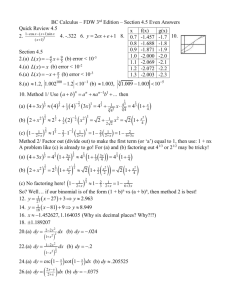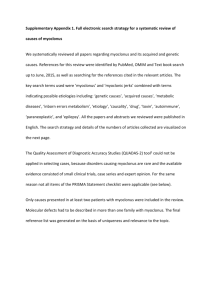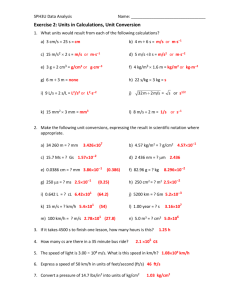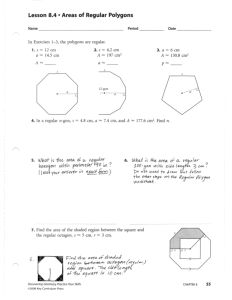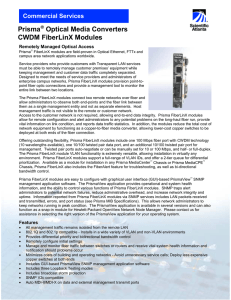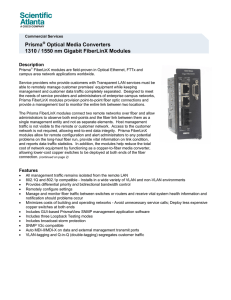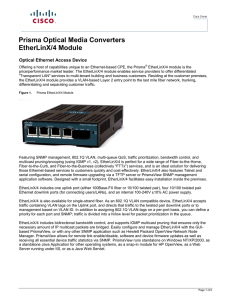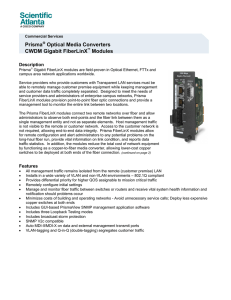HIE-ISOLDE_Spectrometers_PRISMA_V3_andres
advertisement
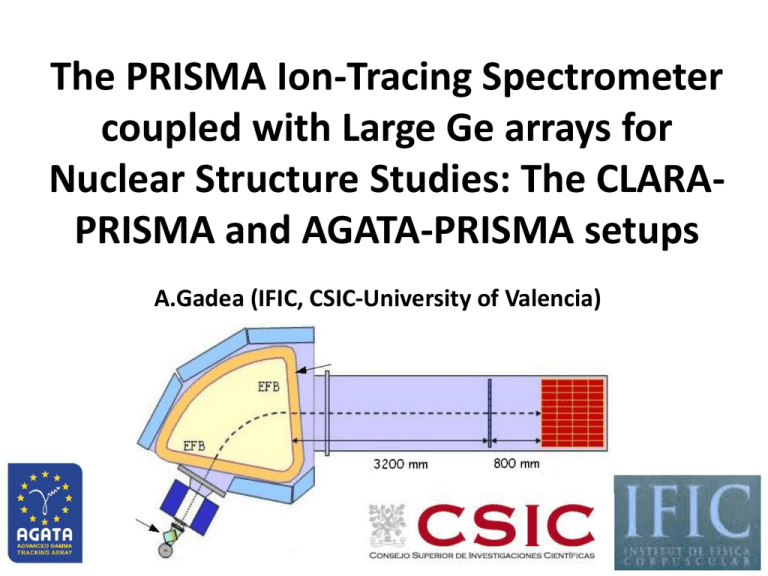
The PRISMA Ion-Tracing Spectrometer coupled with Large Ge arrays for Nuclear Structure Studies: The CLARAPRISMA and AGATA-PRISMA setups A.Gadea (IFIC, CSIC-University of Valencia) PRISMA Ion Tracing Spectrometer Q A. Stefanini et al., NPA701 (02) 217c. D MWPPAC 10 sect. X,Y & TF MCP Start Det. X,Y & TI 6m PRISMA: Large acceptance tracking Magnetic Spectrometer Q-D Designed for the HI-beams from XTU-ALPI W = 80 msr DZ/Z 1/60 (Measured) IC DA/A 1/190 (Measured) TOF Energy acceptance ±20% Max. Br = 1.2 T.m. Ionisation Chamber 10x4 sect. DE - E MCP Start Detector G.Montagnoli et al. NIM A547, 455 (05) Focal Plane Detectors: MWPPAC S.Beghini et al. NIM A551, 364 (05) The Focal Plane Detector: IC IC Maximum working pressure 100 hPa 10 x 4 sections 10x25 cm2 Courtesy of E. Fioretto INFN - LNL Electron Drift Velocity Electron Drift Velocity (cm/ s) E.Fioretto et al. LNL Ann. Rep. 2002 p.148 S.Beghini et al. NIM A551, 364 (05) Z 14 12 10 8 6 4 CF4 CH4 2 0 C4H10 0 1 2 3 E/p (V/cm hPa) 4 5 PRISMA detectors: present configuration ~ 600 g/cm2 X C foil 20 g/cm2 thick Mylar foils 1.5 m thick 195 MeV 36S + 208Pb, lab = 80o Z=28 Y position DE (a.u.) X position Z=16 E. Fioretto Courtesy of E. Fioretto INFN - LNL E (a.u.) INFN - LNL New FPDs for low energy heavy-ions ~ 420 g/cm2 Secondary electron detector under production at University of Manchester Heavy ions (E<10 MeVA; Z>10) Emissive foil (Vf = 10 kV) Mylar 0.6 m + Al 30 nm ~ 80 g/cm2 Extraction Acceleration E Guiding Focusing B Accelerating grid (Vg = 0 V) Thin window (0.9 m) 0V Y strips (Wires) Detection LPMWPC PPAC MWPC HV + X strips 0V C4H10 – 5hPa Courtesy of E. Fioretto INFN - LNL Dt ~ 150 ps DX, DY ~ 2 mm PRISMA detectors for light Ions and low energy heavy ions: SeD under development ~ 280 g/cm2 C foil 20 g/cm2 thick Mylar foils 0.6 m – 1.5 m thick E. Fioretto Courtesy of E. Fioretto INFN - LNL INFN - LNL BEAM LIKE v/c A/q true recoil velocity TARGET LIKE trajectory in dipole DIPOLE IC Energy [a.u.] Tracking on PRISMA q TRUE RECOIL VELOCITY+ TRAJECTORY IN DIPOLE+ TOTAL ENERGY rv [a.u.] MWPPAC IONIZATION CHAMBER MCP Start Detector MCPMWPPAC DTOF=0.5 ns S.Beghini et al. NIM A551, 364 (05) G.Montagnoli et al. NIM A547, 455 (05) A IC Energy [a.u.] 5‰ Energy resolution Z IC Range [a.u.] m Br TOF q Monte Carlo Simulation of the PRISMA Response Function Monte Carlo simulation based on the ray tracing code originally developed by A. Latina and E. Farnea The charge states transported in the simulation have to be the same as in the experiment 48Ca Charge States Focal Plane detector MCP entrance detector D.Montanari et al. EPJA (11) in press Courtesy of D.Montanari INFN-Milano Response for an Uniform Distribution for 48Ca Transport in PRISMA of a uniform distribution in (Ek,,f) EK = [200, 400] MeV J = [ 10°, 40°] j = [-40°,40°] Q = 19+ D.Montanari et al. EPJA (11) in press Q = 18+ Q = 16+ Courtesy of D.Montanari INFN-Milano Calculated PRISMA Response with INPUT theoretical distributions (ds/dWdE)GRAZING (ds/dWdE)GRAZING-Transp * f(E,) 47Ca 49Sc Ek GRAZING model: (A.Winther, Nucl.Phys.A594 (1995)203) GRAZING input GRAZING-Transp GRAZING-Transp * f(E,) D.Montanari et al. EPJA (11) in press Courtesy of D.Montanari INFN-Milano A&Z identification CLARA-PRISMA at LNL Clover Detector array PRISMA Spectrometer “in-beam” g-ray A. Gadea et al., EPJA20 (04) 193 25 Euroball Clover detectors (GammaPool) Performance at Eg= 1.3MeV Efficiency ~ 3 % Peak/Total ~ 45 % FWHM < 10 keV (at v/c = 10 %) AGATA – PRISMA PRISMA: large acceptance spectrometer for binary reactions GRAZING and DIC REACTIONS QUASI-ELASTIC DEEP-INELASTIC J. Wilczynski, Phys. Lett. 47B(1973) 484 QUASI-ELASTIC Production of Projectile-like and target-like nuclei. Production of n-rich nuclei. Identification of products with complementary detectors or by g-spectroscopy of the partners is required DEEP-INELASTIC Grazing reactions transferring several nucleons, a tool to study neutron-rich nuclei Target Beam Approximate cross sections [mb] Deep-inelastic reactions used since thick target pioneering work of R.Broda et al. (PLB 251 (90) 245) 82Ge Use of Multinucleon-transfer at the grazing angle triggered by the LNL reaction mechanism group. ~0.6mb 80Zn ~2b 82Se + 238U 505 MeV Effective Pairing Term Grazing calculations Sequential Transfer L.Corradi et al., Phys.Rev.C59 (99)261, Theory: G.Pollarolo N=28-40 neutron-rich A~50-70 nuclei p3/2 p1/2 f5/2 g9/2 64Ni (400 MeV )+ 238U CLARA-PRISMA G = 64o Doubly magic character R.Broda et al., PRL 74 (95) 868 f7/2 DEFORMATION Magic Character of N=40 vanishes for Z<28. Evolution of the collectivity towards N=40 in the Fe (Z=26) isotopes First indication of N=32 shell gap in Cr isotopes J.I.Prisciandaro et al PLB510(01)17 Present in the in the 1f7/2 band in 55,57V S.Lunardi, S.M.Lenzi, S.Freeman Beyond N=40 in Fe isotopes Comparison 64Ni and 70Zn onto 238U 64Ni+238U 28 27 26 25 24 64 Ni Co - 2p 60 +4n 62 66 Fe Mn Cr 34 35 36 37 38 39 40 70Zn+238U 30 29 28 27 26 70 Zn Cu - 4p Ni 66 Co 68 Fe 37 38 39 40 41 42 N=40 and N=42 Fe isotopes 70Zn@460MeV onto 238U N=40 f 5/22 g 92/ 2 N=42 f 5/22 g 94/ 2 The experimental level schemes are more quadrupole-collective than the calculated ones. Quadrupole collectivity can be produced by including the d5/2 shell in the model space (A. Zuker et al., PRC52 R1741 (1995)). S.M. Lenzi et al., LNL Annual Report 2007 and to be published Differential RDDS Measurement in the 48Ca region with CLARA D.Mengoni, J.Valiente, A.Gadea, A.Dewald Differential Plunger for angles ≠ 0o 48Ca v' v 310MeV + 1mg/cm2 208Pb Degrader 4mg/cm2 Mg Eγ Good Mass Resolution Eγ’ Doppler corrected Lifetime of the 2+ in 50Ca 48Ca Is Iu J.J. Valiente-Dobón et al. PRL 102 (09) 242502. τ = 96 ± 3 ps The obtained effective charges (IS) are different to the ones obtained nearby N≈Z (IS+IV) → Possible isospin dependence of the effective charges. 64Ni Inelastic Scattering v' 6.7 T1/2 (4+) = 4.214 ps v' 7.1 T1/2 (4+) = 4.713 ps v' 7.5 T1/2 (4+) = 4.815 ps Differential RDDS Measurements at the AGATA – PRISMA setup with the Cologne Plunger Lifetimes: ~0.5 to ~500 ps at v/c ≈ 10% Also at EXOGAMVAMOS Cologne plunger setup for RDDS measurements in grazing reactions A.Dewald, Th. Pissulla, J. Jolie IKP-Uni. Köln Before Degrader After Degrader M-C simulation by D.Mengoni SPECIFICATIONS OF ION TRACING SPECTROMETERS Summary and outlook: •PRISMA is a Ion Tracing Spectrometer for Heavy Ions with large acceptance (80 msr). •Coupled with Large Ge arrays it has been a very useful tool to study moderately neutron-rich nuclei produced by Grazing reactions •PRISMA can be use for any binary reaction with stable beams and RIBs. Any facility will benefit from such instrument •Drawback: complexity of the response function in case cross section measurements are performed


